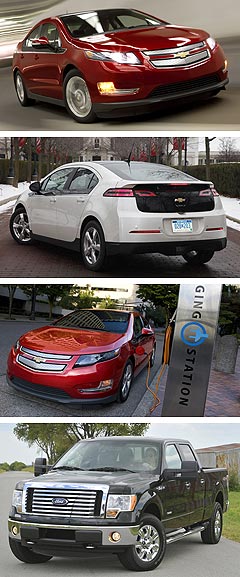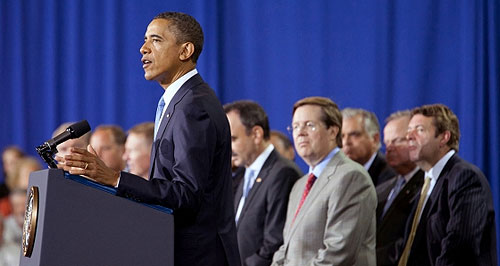Make / Model Search
News - General News - EmissionsUS applies fuel economy screwsMeeting: President Obama shakes hands with Ford president and CEO Alan Mulally in Washington. Australia set to move on CO2 emissions as Obama gets 4.3L/100km fuel standard1 Aug 2011 THE Australian government is poised to take the next step towards mandatory motor vehicle carbon dioxide emissions standards, hard on the heels of a United States decision last week to cut average light-vehicle fuel consumption by half over the next 14 years. President Barack Obama’s administration on Friday reached agreement with major motor companies to set a target of 54.5 miles per gallon (4.3 litres per 100km) by 2025 for passenger cars and light trucks, compared with the current 27.5mpg (8.55L/100km). The proposed standard equates to 100 grams of CO2 per kilometre, a reduction of 36 per cent on the current US target of 156gm/km by 2016. The new US rules will not be locked in until July next year, but major car companies such as General Motors, Ford and Toyota USA have already said they will support the move after winning some concessions from the government, which originally had sought a 56mpg (4.2L/100km) standard. However, Volkswagen and Mercedes-Benz have voiced concerns over concessions for Detroit’s full-sized pick-ups. Said VW in a statement: “It (the standard) places an unfairly high burden on passenger cars, while allowing special compliance flexibility for heavier light trucks. “Passenger cars would be required to achieve five per cent annual improvements, and light trucks 3.5 per cent annual improvements. “The largest trucks carry almost no burden for the 2017-2020 timeframe, and are granted numerous ways to mathematically meet targets in the outlying years without significant real-world gains.” The Australian government delayed its discussion paper on its proposals for a mandatory CO2 limit on Australian light vehicles until after the release of its carbon pricing arrangements this year, but industry insiders believe it is now only a matter of time before Canberra initiates its own moves to tighten vehicle fuel consumption with compulsory CO2 targets to be phased in over a number of years. The first step probably will be a framework for submissions from interested parties, including the motor companies, following the same path as the recent government moves to phase in Euro 5 and 6 toxic exhaust gas restrictions between 2013 and 2018.  Left: Chevrolet Volt. Below: Ford F-150 EcoBoost. Left: Chevrolet Volt. Below: Ford F-150 EcoBoost.The Australian car industry has championed voluntary CO2 cuts, pointing to reductions in the National Average Carbon Emission (NACE), from 252g/km in 2002 to 212g/km in 2010. But the Labor Party went to the polls last year promising to address the issue, with prime minister Julia Gillard quoting a 190g/km national average from 2015 and a further reduction to 155gm/km by 2024. In Europe, the EU is phasing in a 130g/km limit for passenger cars by 2012 (with conditions) and has set a limit of 95g/km by 2020. Comparing Australian, European and US fuel economy and CO2 emissions is fraught, as different tests are applied in each case. For example, SUVs are not included in the US, and in Europe the rule applies only to passenger cars. As well, the US tests allow concessions for items such as the introduction of new, more greenhouse-friendly air-conditioning gas, reducing the fuel economy standard to about 50mpg (4.7L/100km). The US rules also allow a range of vehicle ancillaries to be turned off during the test. The Detroit Free Press estimates that a vehicle that meets the proposed 54.5mpg (4.3L/100km) government standard is likely to arrive in the showrooms with a fuel economy window sticker claiming 35-40mpg (6.7L/100km-5.9L/100km). The US move to new standards effectively starts this year as it follows on from previous tightening of fuel economy levels that are due to come into effect this September and cover the period to 2016. Car-makers face a five per cent cut in passenger car fuel consumption each year until 2025, while light trucks will have to make 3.5 per cent gains until 2021 and then step up the pace to five per cent to 2025. President Obama said the standards would collectively save consumers $US1.7 trillion in fuel costs over the life of their vehicles. He said it would save six billion tonnes of CO2 emissions and cut US oil imports by up to 2.2 million barrels a day. “This agreement on fuel standards represents the single most important step we’ve taken as a nation to reduce our dependence on foreign oil,” Mr Obama said. America’s biggest motor company, General Motors, whose CEO Dan Akerson attended the announcement along with heads of nine other companies, later released a statement saying it had “agreed in principle” to the new standards, which it described as ambitious. “This proposed rule presents a path forward that greatly improves fuel economy while preserving customer choice and future industry growth,” GM said. “GM plans to pursue the technical challenge ahead and to lead in delivering new fuel-saving technologies in cars and trucks customers want to buy and can afford.” Toyota USA president James Lentz said Toyota intended to meet the challenge. “We share the administration’s goal of achieving major advances in clean, fuel-efficient vehicles,” he said. “Obviously, there is still a great deal of uncertainty as to how the market will respond and what vehicle technologies consumers will embrace, which is why we are rolling out and testing a range of alternative fuel options.” Among the concessions apparently won by the car-makers is a mid-term review of the new restrictions, presumably in case the companies are struggling to make meet the standard and stay financially viable. Until this year, American fuel economy standards – know as Corporate Average Fuel Economy (CAFE) – had sat on 27.5mpg (8.55L/100km) for 25 years, with congress blocking attempts to apply the screws. Commentators in Detroit say most of the fuel savings needed to meet the new standards will be made by improvements to internal combustion engines, with hybrids also playing a part. At last week’s announcement of the new US standards, Ford wheeled out its new EcoBoost V6 F150 pick-up, while GM had a plug-in petrol/electric Chevrolet Volt on display.  Read more |
Click to shareGeneral News articlesResearch General News Motor industry news |










Facebook Twitter Instagram